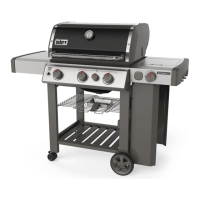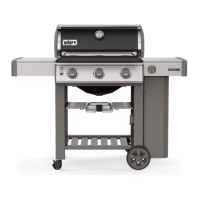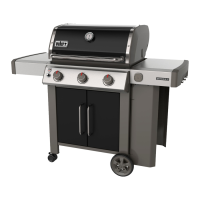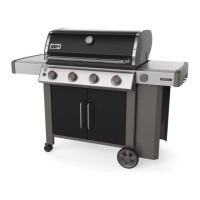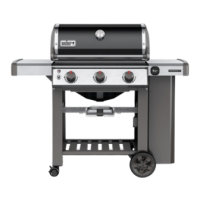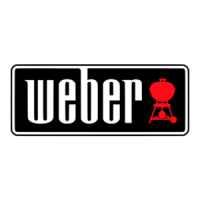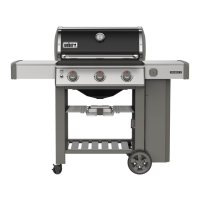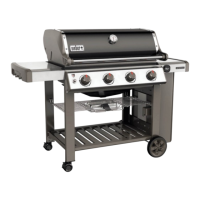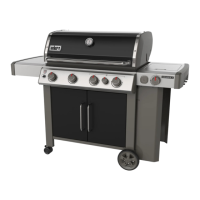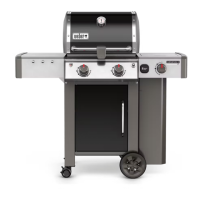8
Getting Started
Important Information about
LPGas & GasConnections
What is LPG?
Liquefied petroleum gas, also called LPG or LP gas, is
the flammable, petroleum-based product used to fuel
your barbecue. It is a gas at moderate temperatures
and pressure when it is not contained. But at moderate
pressure inside a container, such as a cylinder, LPG is
a liquid. As pressure is released from the cylinder, the
liquid readily vaporises and becomes gas.
Safe Handling Tips for LPG Cylinders
• A dented or rusty LPG cylinder may be hazardous and
should be checked by your LP gas supplier. Donot use
a cylinder with a damaged valve.
• Although your LPG cylinder may appear to be empty,
gas may still be present, and the cylinder should be
transported and stored accordingly.
• The LPG cylinder must be installed, transported, and
stored in an upright, secure position. Cylinders should
not be dropped or handled roughly.
• Never store or transport the LPG cylinder where
temperatures can reach 50°C (125°F) (the cylinder will
become too hot to hold by hand).
LPG Cylinder Requirements
• Use cylinders with a minimum capacity of 3 kg and
amaximum capacity of 13 kg.
What is a Regulator?
To connect the device to the gas tank, one must
purchase a regulator (sold separately). This is a device
meant to control the gas pressure and keep the gas
pressure uniform and per standards when gas is
released from the LPG tank.
Regulator and Hose Requirements
• In the United Kingdom, this barbecue must be fitted
with a regulator complying with BS 3016, having a
nominal output of 37 millibars.
• The length of the hose must not exceed 1.5 metres.
• Avoid kinking the hose.
• Replacement regulator and hose assemblies must be
as specified by Weber-Stephen Products LLC.
• Please follow the requirements of the Israeli Standards
Institute.
m IMPORTANT: We recommend that you replace
the gas hose assembly on your gas barbecue
every five years. Some countries may have
requirements that the gas hose be replaced
within less than five years, in which case that
country’s requirement would take precedence.
For replacement hose, regulator, and valve
assemblies, contact the Customer Service
Representative in your area using the contact
information on our web site.
Log on to weber.com.
GENESIS II Burner Valve Orifice Sizes & Consumption Data
BURNER VALVE ORIFICE SIZES
Country Gas Category 3 Burner Models 4 Burner Models
China, Cyprus,
CzechRepublic, Denmark,
Estonia, Finland, HongKong,
Hungary, Iceland, India,
Israel, Japan, Korea,
Latvia, Lithuania, Malta,
Netherlands, Norway,
Romania, Russia, Singapore,
SlovakRepublic, Slovenia,
South Africa, Sweden,
Turkey
I
3B/P
(30 mbar or 2.8 kPa) Main Burners 1,02 mm
Sear Burner 0,84 mm
Side Burner 1,02 mm
Main Burners 0,98 mm
Sear Burner 0,84 mm
Side Burner 1,02 mm
Belgium, France,
Greece, Ireland, Italy,
Luxembourg, Portugal,
Spain, Switzerland,
UnitedKingdom
I
3+
(28-30/37 mbar) Main Burners 0,94 mm
Sear Burner 0,78 mm
Side Burner 0,96 mm
Main Burners 0,91 mm
Sear Burner 0,78 mm
Side Burner 0,96 mm
Poland I
3P
(37 mbar) Main Burners 0,94 mm
Sear Burner 0,78 mm
Side Burner 0,96 mm
Main Burners 0,91 mm
Sear Burner 0,78 mm
Side Burner 0,96 mm
Austria, Germany I
3B/P
(50 mbar) Main Burners 0,86 mm
Sear Burner 0,72 mm
Side Burner 0,85 mm
Main Burners 0,82 mm
Sear Burner 0,72 mm
Side Burner 0,85 mm
CONSUMPTION DATA
3 Burner Models 4 Burner Models
17,5 kW Propane
20,1 kW Butane
1251 g/h Propane
1463 g/h Butane
20,2 kW Propane
23,3 kW Butane
1444 g/h Propane
1696 g/h Butane
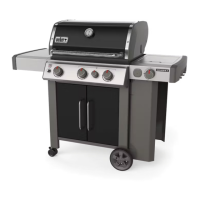
